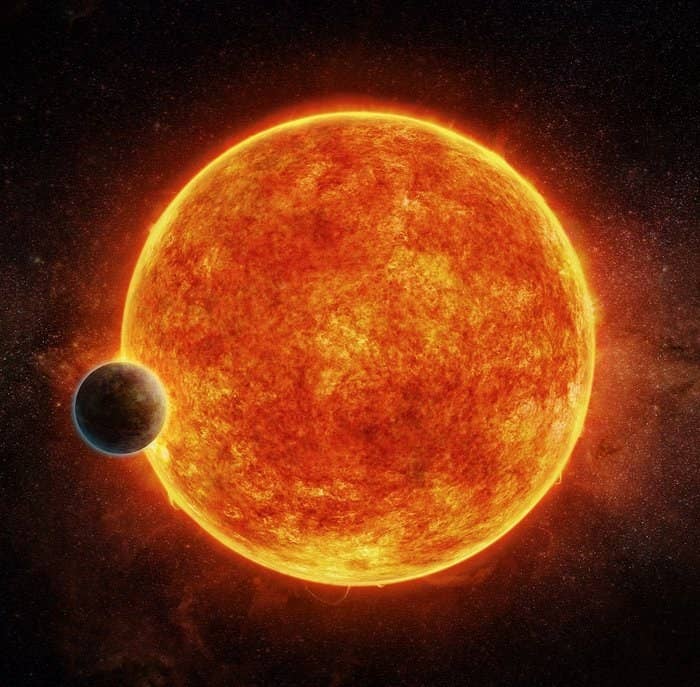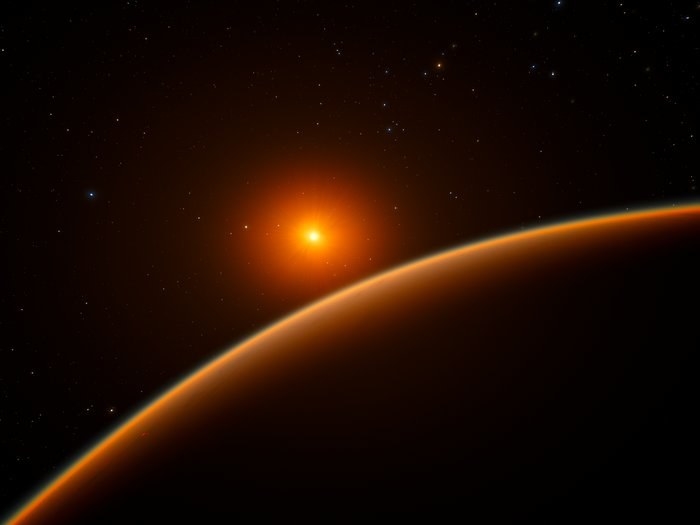
An Earth-like planet orbiting a small, cool star not far from our sun could be the best candidate so far for detecting life.
The "super-Earth", a rocky planet about six times the mass of Earth, orbits close in around the star LHS 1140, a red dwarf star about 40 light years from Earth. It's in the "Goldilocks region", an orbit where it's not too hot and not too cold, so liquid water can exist on its surface. It was spotted by scientists at the MEarth observatory, and the research is published today in Nature.
There have been nearly 3,500 exoplanets (planets outside our own solar system) discovered – a number that is growing daily, with NASA announcing the discovery of 715 new planets by the space telescope Kepler on 29 February 2014 alone. But LHS-1140b, as the new planet is known, is exciting to scientists because it may be possible to carry out an analysis of its atmosphere with existing telescopes.
"The star is close, and small, and quiet, in terms of flares and activity," Dr Jason Dittmann, an astrophysicist at the Harvard Smithsonian Centre for Astrophysics and one of the authors of the study, told BuzzFeed News. "So it's ticking all the boxes."
"There have been lots of exoplanet discoveries," Dr Lewis Dartnell, an astrobiologist at the University of Westminster who was not involved in the research, told BuzzFeed News. "But most of them are too far away, so the planet is too dim – you can't get enough photons for spectroscopy of their atmospheres.
"This one is very exciting, in terms of it being close enough to do something about it."
Spectroscopy is the study of the light given off by different chemicals. Each chemical gives off a unique spectral "fingerprint" of different wavelengths of light. It's how we know what stars are made of.

Because LHS-1140b is so close, and the star it is orbiting is so dim, it will be comparatively visible. That means that, using telescopes that are currently being built, and even ones that currently exist, it may be possible to get some information about its atmosphere.
"We're going to try to do it with some telescopes that exist now," says Dittmann. "We can start chipping away at it with the Hubble Space Telescope and some of the big ground-based telescopes.
"But it's mainly a study for the future." He mentions the James Webb Space Telescope, which will be launched in 2018, and the Giant Magellan Telescope, which will be commissioned in 2022, as possible sources of more information.
The telescopes will mainly be looking for oxygen. "That's the big one that everyone wants to see," says Dittmann.
That's because, on Earth, oxygen is produced by life – specifically, by plants, algae, and bacteria that use the sun's energy to strip carbon from carbon dioxide and release the oxygen. But oxygen is a highly reactive gas, so it doesn't stay in the atmosphere on its own for very long: It reacts with other things to form compounds. That means that if oxygen is detected in large quantities in a planet's atmosphere, there must be some chemical process that is making it.
That doesn't necessarily mean life, says Dartnell. "There are ways of making oxygen in an atmosphere, in the short term, that don't involve life," he says.
"What happened on Venus is that the planet got so hot that the seas boiled, and water vapour got high enough into the atmosphere that it started getting split into hydrogen and oxygen by ultraviolet radiation from the sun."
That built up enough oxygen in the atmosphere to be detectable by telescopes at the time, he said. "But that is basically the planet dying, boiling itself dry with this runaway greenhouse effect."

So if oxygen is discovered, the next thing to look for will be methane. "People talk about oxygen plus methane," says Dittmann, "because those chemicals don’t get on very well. Oxygen will destroy the methane very quickly, so that could be life."
Even then, it could be some geological phenomenon, such as volcanoes. But the discovery of oxygen plus methane in the atmosphere would be good, if not definitive, evidence of a biological process.
There are some reasons to think that, even if LHS-1140b is a good candidate for analysis, it may not be such a good candidate for life actually arising in the first place. Because the star is so dim and cool, the Goldilocks region is much closer in than it is around our star. That means that the planet is likely to be "tidally locked" – with the same face always towards the star, just as we can only ever see one side of the moon from Earth.
"When you've got a planet tidally locked around a star, that means one side in eternal light and the other in eternal darkness," says Dartnell. "That means difficulties in terms of climate. We think you need a stable climate over a long period for life to emerge and spread around the planet.
"But if you've got a tidally locked planet, you get a hot side and a cool side. The cold side may become so cold that the atmosphere itself starts to condense and freeze, so you get nitrogen snow and carbon dioxide snow. If it strips the atmosphere out it can destroy the habitable conditions across the whole planet."
That is possible, says Dittmann, but there are ways for a planet to redistribute its heat. "I'm not too worried. An atmosphere and an ocean could redistribute heat from the light to the dark." He also points out that Mercury is in a similar situation, and isn't quite tidally locked – it just rotates slowly, with two Mercurian "days" for every three Mercurian "years" – and even a rotation of that speed may be enough to prevent the atmosphere freezing.
So overall, it's the best candidate so far for life outside our solar system, says Dittmann. "The TRAPPIST results [earlier this year, in which seven planets were found around a nearby star] were fantastic, but our star is much quieter and doesn't flare, so the planet won't be being bombarded by as much high-energy radiation.
"Maybe there's a better candidate out there, waiting to be discovered, but at least we're not targetless."
Whatever we see around LHS-1140b, that's just the start. "If we find one planet with oxygen, we can't say that's definitely life," says Dartnell. "But if we find 10 or 20, there might be one or two where it's caused by runaway greenhouse effects, but it's not likely to be all of them."

